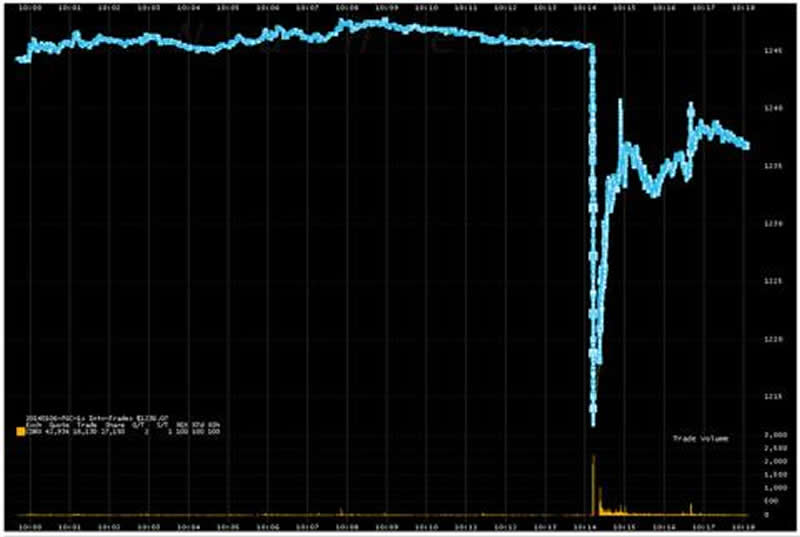Was Mini Flash Crash Bearish for Gold?
Commodities / Gold and Silver 2014 Jan 17, 2014 - 11:20 AM GMTBy: Submissions
 Boris Mikanikrezai writes: Let me start by wishing you a very happy new year! I would like to go back on what happened on January 6, 2014.
Boris Mikanikrezai writes: Let me start by wishing you a very happy new year! I would like to go back on what happened on January 6, 2014.
February 2014 Gold Futures on January 6, 2014

Source: Nanex
COMEX gold futures plunged by $30 or about 3% from $1,245.50 to $1,212.60 within a minute between 10:14 a.m.33 and 10:15 a.m. EST. Gold prices recovered most of their losses after the volatility triggered a “Velocity Logic” event, resulting in a 10-second pause in COMEX February gold futures. By11:44 a.m. EST, U.S. gold futures for February delivery rebounded to $1,239.90.
As a reminder, Velocity Logic is a mechanism adopted by the CME (which owns the exchange), which has the ability to stop trading if it detects market movement up or down outside a predefined number of points within a predefined time.
Let’s examine what could have caused this mini flash crash?
A shock in economic data
The crash came about 14 minutes after the release of U.S. factory orders and ISM services index data. Factory orders rose by 1.8% in line with market expectations while ISM Non-Manufacturing PMI came at 53.0 below market expectations at 54.6. This does not seem to fit.
Fat finger
At the first glance, it could appear as such. However, the CME said in an email that “all trades stand and our technology performed as designed.” Moreover, the fact that we have already seen this kind of sharp moves several times suggests that the “fat finger” thesis is invalidated
Large order
A market participant aims to push the market down with a large order (perhaps to protect is substantial short position) and either he/she underestimates the lack of liquidity in the market or he/she is fully aware so he/she takes advantage of it. Interestingly, it is important to note that large speculators (as known as managed money) increased their short positions to a record 82,765 contracts short in the week toDecember 24 even if they reduced their short positions to 78,334 contracts in the week to December 31 according to CFTC reports.
Trading liquidation
A market participant such as a big hedge fund must liquidate a non-profitable long position to rebalance its investments.
Algorithmic Trading
Fast and sharp market movements and abnormally high volumes of COMEX gold trading suggest the involvement of algorithmic trading.
In one minute, 11,000 contracts traded while the average daily volume is 110,000 contracts. Even further, 4,200 contracts traded in just one second. To put this into perspective, recently we have already seen several times 1,000 contracts traded in one second (which is extremely high), triggering a momentary halt in the COMEX. So more than 4,000 contracts traded in one second is extremely rare and the fact that people are able to trade that much in this short period of time is quite perplexing.
I believe this is the most likely explanation even though I cannot prove it at this stage. Market participants, using similar algorithm programs, place orders at the same price because sell or buy signals are the result of computerized trading programs.
Mini Flash Crash= Bearish for the gold market?
At the first glance, it is tempting to view the retracement as a positive development, suggesting that market participants are not expecting further decline in gold prices. However, I suspect the retracement is just technical. From a technical perspective, it is important to note that the $1,180 level has been proven to be a strong support as it has been tested a couple of times in the recent past. As a matter of fact, we have already seen that following the conclusion of the December FOMC Meeting (December 18), when gold prices declined sharply from $1,244 per ounce to $1,187 per ounce on December 19, before rebounding sharply as the $1,180 was not broke.
However, these kinds of sharp moves affect negatively the confidence in the market traditionally, even though it retraces initially. Indeed, a rational investor tends to be out of the market place after surprising increased volatility and illogical moves. Interestingly, David Govett from Marex Spectron reported in his Bullion Thoughts that he “knows for a fact that an awful lot of people got stopped out of positions yesterday afternoon and those particular players will wait a long time before they get back in and are completely disgusted with the move. From a medium term perspective, this suggests that the gold market is not ready yet to recover as market participants are still worried about further market decline in prices. Since the beginning of 2013, the risk to gold is skewed to the downside.
In sum, this mini flash crash suggests a bearish development going forward.
Boris Mikanikrezai
© 2014 Copyright Boris Mikanikrezai- All Rights Reserved Disclaimer: The above is a matter of opinion provided for general information purposes only and is not intended as investment advice. Information and analysis above are derived from sources and utilising methods believed to be reliable, but we cannot accept responsibility for any losses you may incur as a result of this analysis. Individuals should consult with their personal financial advisors.
© 2005-2022 http://www.MarketOracle.co.uk - The Market Oracle is a FREE Daily Financial Markets Analysis & Forecasting online publication.



